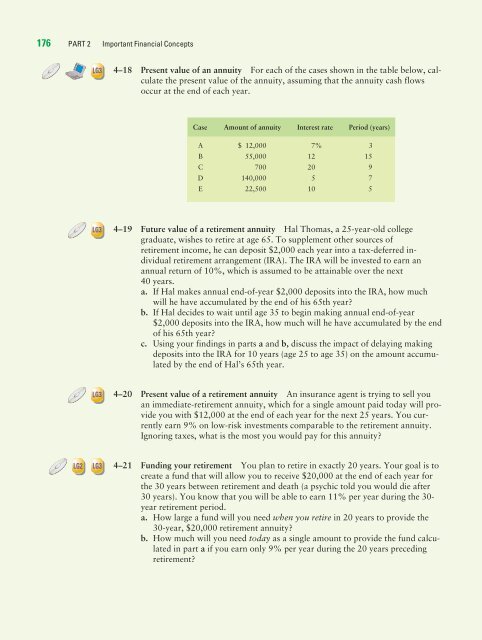Read the Chapter 4 E-Book
Read the Chapter 4 E-Book
Read the Chapter 4 E-Book
You also want an ePaper? Increase the reach of your titles
YUMPU automatically turns print PDFs into web optimized ePapers that Google loves.
176 PART 2 Important Financial Concepts<br />
LG3<br />
LG3<br />
LG3<br />
LG2 LG3<br />
4–18 Present value of an annuity For each of <strong>the</strong> cases shown in <strong>the</strong> table below, calculate<br />
<strong>the</strong> present value of <strong>the</strong> annuity, assuming that <strong>the</strong> annuity cash flows<br />
occur at <strong>the</strong> end of each year.<br />
Case Amount of annuity Interest rate Period (years)<br />
A $ 12,000 7% 3<br />
B 55,000 12 15<br />
C 700 20 9<br />
D 140,000 5 7<br />
E 22,500 10 5<br />
4–19 Future value of a retirement annuity Hal Thomas, a 25-year-old college<br />
graduate, wishes to retire at age 65. To supplement o<strong>the</strong>r sources of<br />
retirement income, he can deposit $2,000 each year into a tax-deferred individual<br />
retirement arrangement (IRA). The IRA will be invested to earn an<br />
annual return of 10%, which is assumed to be attainable over <strong>the</strong> next<br />
40 years.<br />
a. If Hal makes annual end-of-year $2,000 deposits into <strong>the</strong> IRA, how much<br />
will he have accumulated by <strong>the</strong> end of his 65th year?<br />
b. If Hal decides to wait until age 35 to begin making annual end-of-year<br />
$2,000 deposits into <strong>the</strong> IRA, how much will he have accumulated by <strong>the</strong> end<br />
of his 65th year?<br />
c. Using your findings in parts a and b, discuss <strong>the</strong> impact of delaying making<br />
deposits into <strong>the</strong> IRA for 10 years (age 25 to age 35) on <strong>the</strong> amount accumulated<br />
by <strong>the</strong> end of Hal’s 65th year.<br />
4–20 Present value of a retirement annuity An insurance agent is trying to sell you<br />
an immediate-retirement annuity, which for a single amount paid today will provide<br />
you with $12,000 at <strong>the</strong> end of each year for <strong>the</strong> next 25 years. You currently<br />
earn 9% on low-risk investments comparable to <strong>the</strong> retirement annuity.<br />
Ignoring taxes, what is <strong>the</strong> most you would pay for this annuity?<br />
4–21 Funding your retirement You plan to retire in exactly 20 years. Your goal is to<br />
create a fund that will allow you to receive $20,000 at <strong>the</strong> end of each year for<br />
<strong>the</strong> 30 years between retirement and death (a psychic told you would die after<br />
30 years). You know that you will be able to earn 11% per year during <strong>the</strong> 30year<br />
retirement period.<br />
a. How large a fund will you need when you retire in 20 years to provide <strong>the</strong><br />
30-year, $20,000 retirement annuity?<br />
b. How much will you need today as a single amount to provide <strong>the</strong> fund calculated<br />
in part a if you earn only 9% per year during <strong>the</strong> 20 years preceding<br />
retirement?

















